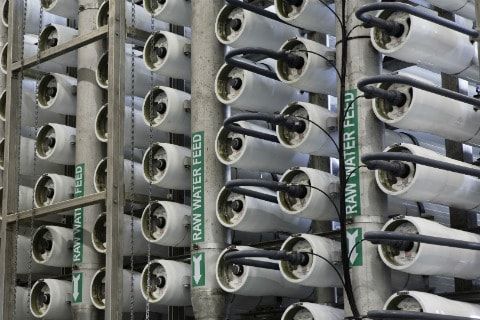Reverse Osmosis Brine Treatment: Tech Advancements to Minimize Volume & Cost
Published on by Sydney Juzenas, Marketing Specialist at Saltworks Technologies in Technology

Reverse osmosis unit (Image source: Saltworks)
How does Reverse Osmosis Work?
Reverse osmosis (RO) is the workhorse of desalination. High pressure is used to drive water through specially-engineered semipermeable membranes that reject salt ions. Recovery increases with higher brine concentration relative to inlet salinity, squeezing more freshwater from the salt water. Osmotic pressure also increases with brine concentration, which requires higher driving pressures and reduces freshwater permeate flux requiring larger membrane area.
Historically, there are three pressure classes for RO membranes: 300 psi, 600 psi and 1200 psi. The higher the pressure class, the higher the brine volume reduction potential on a nonscaling fluid. RO membrane vendors are innovating ultra-high-pressure reverse osmosis (UHP-RO) spiral wound membranes capable of 1800 psi. UHP-RO enables brine concentrations up to 130,000 mg/L total dissolved solids (TDS), limiting downstream brine disposal or brine treatment costs.
Reverse Osmosis Limitations
RO brine treatment will be limited by either osmotic pressure increase with salinity, which decays permeate flux to an unsuitable level, or scaling ions or organic fouling that can block the membrane. Most industrial RO applications are scale-limited, for example by silica, calcium sulfate, phosphate, fluoride, iron or barium salts. Organic fouling can be managed by pretreatment, a biocide program, automated high-pH washes, or a “kidney organic removal loop.”
Ionic scale can affect end users in three ways:
- Reliability challenges leading to frequent cleaning or shortened membrane life.
- Recovery left on the table generating more brine than required.
- RO membrane fouling caused by indirect effects such as coagulants intended to help remove precipitated scale upstream.
The problems are compounded in industrial wastewater where the feed chemistry varies, requiring constant monitoring. The BrineRefine technology introduced below solves these challenges by automatically adjusting and preventing use of membrane fouling coagulants.
Key Takeaways:
- Reverse Osmosis is considered the workhorse of desalination. Applied correctly, Reverse Osmosis Brine Treatment can be highly effective and lower cost than thermal alternatives.
- RO recovery and RO brine concentration is limited by osmotic pressures or membrane scaling; both limits have been increased by new technology.
- New ultra high pressure RO membranes can achieve pressures of 1800 psi, 50% higher than previous, enabling 50% brine volume reduction if membrane scaling can be managed.
- A series of techniques described in this document can be used to delay or mitigate scale, but in many cases only chemical softening truly remove the risk.
- A modernized, compact chemical softening technology – BrineRefine – developed for RO brine treatment can be used to entirely remove membrane scaling risk and realize RO’s full brine volume reduction potential.
Read the article in full on the Saltworks website (link below).
Media
Taxonomy
- Reverse Osmosis
- Reverse Osmosis
1 Comment
-
Dear Researchers.
In a RO System we have to deal with rejects ie membrane with heavy salt contents.
The working life of RO Membranes can be increased by doing back - flushing prior total renewals of RO Membranes are done.
It is very hardy to clean for re use and difficult to recycle or place at alternative sites.
At best can be used for land filling in real estate or as road laying with earth matter.
Well wishes.
Prof Ajit Seshadri.